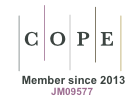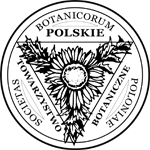Germination of seeds of Avena fatua L. under different storage conditions
Abstract
Keywords
Full Text:
PDFReferences
Rozporządzenie Ministra Rolnictwa i Rozwoju Wsi z dnia 18 kwietnia 2013 r. w sprawie terminów składania wniosków o dokonanie oceny polowej materiału siewnego poszczególnych grup roślin lub gatunków roślin rolniczych i warzywnych oraz szczegółowych wymagań w zakresie wytwarzania i jakości materiału siewnego tych roślin. Dz. U. z 2013 r., poz. 517.
Trzcińska-Tacik H. Dwa typy zmian w zbiorowiskach chwastów zbóż w południowej części Wyżyny Małopolskiej. Zesz Nauk Akad Rol im H Kołłątaja Krak Ses Nauk. 1992;261(33):139–155.
Stanton TR. Oat identification and classification. Washington, DC: United States Department of Agriculture; 1955.
International Seed Testing Association. Międzynarodowe Przepisy Oceny Nasion. Wersja polska. Radzików: Zakład Nasiennictwa i Nasionoznawstwa Instytutu Hodowli i Aklimatyzacji Roślin – Państwowego Instytutu Badawczego; 2008–2013.
James WC. An illustrated series of assessment keys for plants diseases, their preparation and usage. Can Plant Dis Surv. 1971;2(51):39–65.
Kieć J. Zróżnicowanie morfologiczne, ekologiczne i enzymatyczne gatunku Avena fatua L., występującego na polach Polski południowo-wschodniej. Zesz Nauk Akad Rol Krak Rozpr. 2000;260:1–83.
Wall DA. Comparison of green foxtail Setaria viridis and wild oat Avena fatua growth, development, and competitiveness under three temperature regimes. Weed Sci. 1993;41(3):369–378.
Somody CN, Nalewaja JD, Miller SD. The response of wild oat (Avena fatua) and accessions to photoperiod and temperature. Weed Sci. 1984;32(2):206–213.
Trzcińska-Tacik H, Stachurska-Swakoń A. Zmiany we florze chwastów upraw zbożowych w latach 1950–2010: badania na terenie i w otulinie Ojcowskiego Parku Krajobrazowego. In: Partyka J, editor. Granice ingerencji człowieka na obszarach chronionych. Zasady i modele gospodarowania. Ojców: Ojcowski Park Narodowy, Muzeum im. Prof. Władysława Szafera; 2010. p. 397–408. (Prądnik. Prace i Materiały Muzeum im. Prof. Władysława Szafera; vol 20).
Foley ME. Temperature and water status of seed affect after ripening in wild oat (Avena fatua). Weed Sci. 1994;42(2):200–201.
Peters NCB. Competitive effects of Avena fatua L. plants derived from seeds of different weights. Weed Res. 1985;25(1):67–77. http://dx.doi.org/10.1111/j.1365-3180.1985.tb00619.x
Gabińska K, Narkiewicz-Jodko M, Schneider J. Wpływ wieloletniego przechowywania na wartość siewną pszenżyta ozimego. Biul IHAR. 1991;180:43–52.
Rooney J, Brain P, Loh S. The influence of temperature on leaf production and vegetative growth of Avena fatua. Ann Bot. 1989;64(4):469–479.
Stokłosa A. Wpływ światła i temperatury na kiełkowanie odmian botanicznych owsa głuchego (Avena fatua). Ann Univ Mariae Curie-Skłodowska E Agric. 2007;62(2):56–69.
Rines HW, Stuthman DD, Briggle LW, Youngs VL, Jedlinski H, Smith DH, et al. Collection and evaluation of Avena fatua for use in oat improvement. Crop Sci. 1980;20:65–68. http://dx.doi.org/10.2135/cropsci1980.0011183X002000010015x
Luby JJ, Stuthman DD. Evaluation of Avena sativa L. / A. fatua L. progenies for agronomic and grain quality characters. Crop Sci. 1983;23:1047–1052. http://dx.doi.org/10.2135/cropsci1983.0011183X002300060007x
Milach SC, Rines HW, Phillips RL, Stuthman DD, Morikawa T. Inheritance of a new dwarfing gene in oat. Crop Sci. 1997;38:356–360. http://dx.doi.org/10.2135/cropsci1998.0011183X003800020013x
Cavan G, Biss P, Moss SR. Herbicide resistance and gene flow in wild-oats (Avena fatua and Avena sterilis ssp. ludoviciana). Ann Appl Biol. 1998;133:207–217. http://dx.doi.org/10.1111/j.1744-7348.1998.tb05821.x
Morikawa T, Sumiya M, Kuriyama S. Transfer of new dwarfing genes from the weed species Avena fatua into cultivated oat A. byzantine. Plant Breed. 2007;126(1):30–35. http://dx.doi.org/10.1111/j.1439-0523.2007.01309.x
Li R, Wang S, Duan L, Li Z, Christoffers MJ, Mengistu LW. Genetic diversity of wild oat (Avena fatua) populations from China and the United States. Weed Sci. 2007;55(2):95–101. http://dx.doi.org/10.1614/WS-06-108.1
DOI: https://doi.org/10.5586/aa.2015.026
|
|
|






